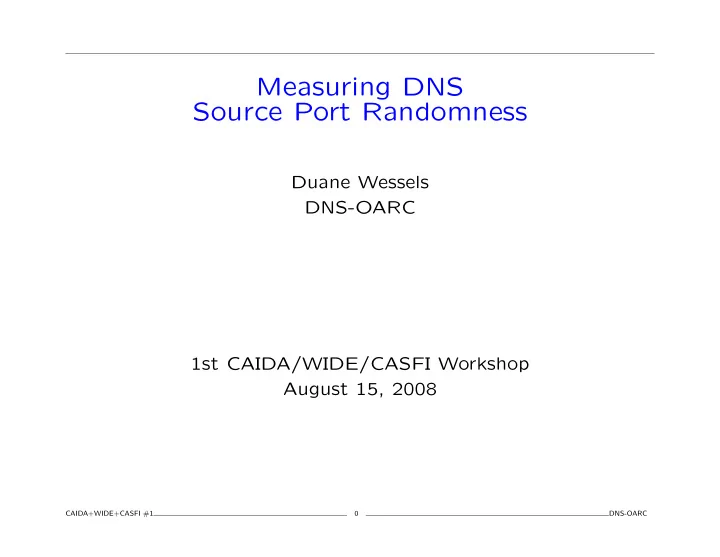

Measuring DNS Source Port Randomness Duane Wessels DNS-OARC 1st CAIDA/WIDE/CASFI Workshop August 15, 2008 CAIDA+WIDE+CASFI #1 0 DNS-OARC
Kaminsky • DNS sucks. – Okay, I’m paraphrashing... • Use random source ports to protect from poisoning • But what about NATs? CAIDA+WIDE+CASFI #1 1 DNS-OARC
How do you know if your DNS ports are random? • http://www.doxpara.com – Web-only – Needs javascript – /etc/resolv.conf nameservers only • Why not something strictly DNS-based? • porttest.dns-oarc.net was born. CAIDA+WIDE+CASFI #1 2 DNS-OARC
Lots of Queries • We need lots of queries from a resolver in order to detect source port randomness. – CNAMEs – Delegations • Resolvers typically limit CNAME chain lengths – To solve looping? – Probably on the order of 10–15? – doxpara uses CNAME chains (5) – Neils Provos test also • Delegation chain – length not limited to my knowledge – requires unique IP per delegation • Make resolvers query for long name like z.y.x.w.v.u.t.s.r.q.p.o.n.m.l.k.j.i.h.g.f.e.d.c.b.a.example.com • Use a CNAME to start to avoid typing the long name CAIDA+WIDE+CASFI #1 3 DNS-OARC
porttest.dns-oarc.net • Implemented in Perl (Net::DNS::Nameserver) • 26 delegations (a–z) and 26 IP addresses • Return TXT record reporting measure of randomness • Use short TTLs to allow test to be repeated from the same location. • Log the results CAIDA+WIDE+CASFI #1 4 DNS-OARC
Measuring Randomness • There are various statistical tests for randomness, but: – I’m not very good with statistics – Some tests assume a Normal distribution – Some tests require a lot of samples. • So I cheat and use standard deviation as a measure of ran- domness. • It’s easy to imagine samples that have high standard devia- tion but low randomness. • To account for repeated ports, I multiply the calculated stan- dard deviation by the ratio of unique samples to total sam- ples. • Its not perfect, but its pretty good and at least some people can understand it. CAIDA+WIDE+CASFI #1 5 DNS-OARC
Standard Deviation • The standard deviation of a sample from a discrete uniform distribution of size N is: � N 2 − 1 σ = 12 • Given the standard deviation of a sample, we can estimate the number of bits in the sample size as: � 12 σ 2 + 1 bits = log 2 • Scoring: Score σ Range bits Range GREAT 3980 – 20,000+ 13.75 – 16.0 GOOD 296 – 3980 10.0 – 13.75 POOR 0 – 296 0 – 10.0 CAIDA+WIDE+CASFI #1 6 DNS-OARC
How It Looks • with dig : $ dig +short porttest.dns-oarc.net txt porttest.y.x.w.v.u.t.s.r.q.p.o.n.m.l.k.j.i.h.g.f.e.d.c.\ b.a.pt.dns-oarc.net. "12.160.37.12 is GREAT: 26 queries in 3.1 seconds \ from 26 ports with std dev 19551" • or... 85.196.68.238 is POOR: 26 queries in 45.5 seconds \ from 24 ports with std dev 69 • or... 216.55.97.81 is POOR: 26 queries in 1.9 seconds \ from 1 ports with std dev 0 CAIDA+WIDE+CASFI #1 7 DNS-OARC
Porttest Queries Per Day 70 60 VU#800113 Leaked published Queries per Day (Thousands) 50 porttest written 40 proper 30 logging 20 10 0 7 14 21 28 4 11 18 Jul08 Aug08 Date
Scores Per Day 100 Whitelisted Poor Good Great 80 60 Percentage 40 20 0 7 14 21 28 4 11 18 Jul08 Aug08 Date
Compare to Sid’s SIE Data
Nominum • Nominum didn’t want to a lot of bits of source port random- ness, for whatever reason. • Implemented additional anti-spoofing/anti-poisoning features. – Such as switching to TCP upon detection of a spoof attempt. • Upset that their nameservers not rated “GREAT.” • Now whitelisted (as of 2008-07-31) based on list of addresses they provide. CAIDA+WIDE+CASFI #1 11 DNS-OARC
Web-based Tool • Vixie suggested to Myself, Dagon, and Neils that OARC should host a web-based randomness test. Google ads would direct users to the page. • The Google ads didn’t quite pan out, but I think the tool turned out nicely. • Advantages: – Good for people that can’t use dig . – Provides lots more information that a TXT response. – Might end up testing more than one resolver at a time. • Disadvantages: – Can only test system-configured resolvers. CAIDA+WIDE+CASFI #1 12 DNS-OARC
Implementation • Begins with an HTTP request. The HTTP response is a redirect to a URL with randomly generated name: Location: http://bd0974adaae13c8268077657.et.dns-oarc.net • The random string becomes a “cookie.” It contains random parts and a timestamp. • The first DNS request returns a CNAME with the cookie expanded to a sequence of separate zones: bd0974adaae13c8268077657.et.dns-oarc.net. 3600 IN CNAME \ b.d.0.9.7.4.a.d.a.a.e.1.3.c.8.2.6.8.0.7.7.6.5.7.et.dns-oarc.net. • The last nameserver returns the web server address where a CGI script uses the cookie to read the query history from an SQL database and present the results. CAIDA+WIDE+CASFI #1 13 DNS-OARC
http://entropy.dns-oarc.net/test/
http://entropy.dns-oarc.net/test/
Web DNS Test Queries Per Day 120 100 Queries per Day (Thousands) 80 60 40 20 0 14 21 28 4 11 18 Jul08 Aug08 Date
Web DNS Test Scores Per Day 100 Whitelisted Poor Good Great 80 60 Percentage 40 20 0 14 21 28 4 11 18 Jul08 Aug08 Date
How To Not Be Poisoned • Deploy DNSSEC • Have good transaction ID randomness • Have good source port randomness • Implement dns-0x20 (random upper-/lower-casing of query name) • Use multiple source addresses (unbound, powerdns) • Detect spoof attempts (nominum, powerdns) • Require multiple matching authoritative answers • Add nonce via EDNS0. • TCP CAIDA+WIDE+CASFI #1 18 DNS-OARC
Final Thoughts • This testing tool is probably “self selecting” such that it tends to attract sources that are not yet updated. It is not a good indicator of patching rates. • Should calculate Wald-Wolfowitz Z-scores and see if they correlate to standard deviation. • Notify network operators of still-vulnerable resolvers. CAIDA+WIDE+CASFI #1 19 DNS-OARC
The End
Recommend
More recommend